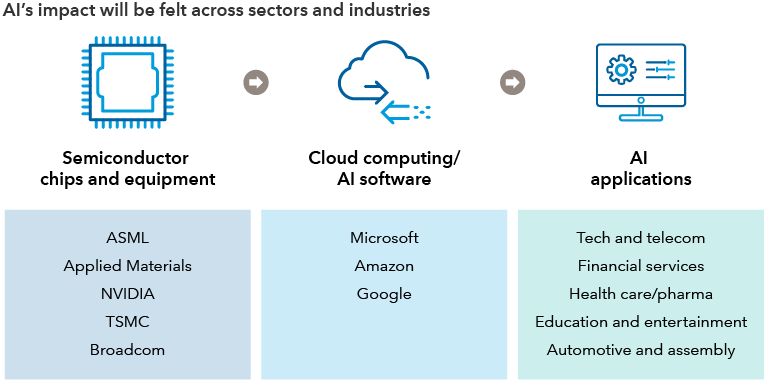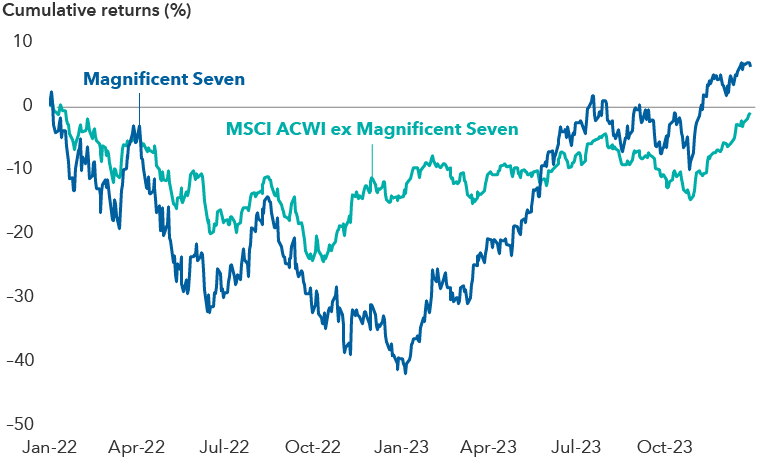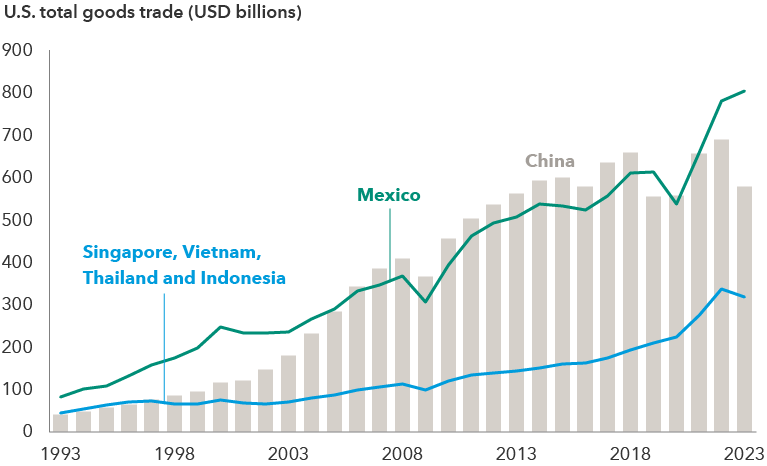What’s right with the world?
A daily diet of negative news can lead even the most experienced investors to lose conviction in their long-term investment plans.
Bad news often overshadows more favorable events. Even after the US avoided a recession and the inflation picture brightened in 2023, many investors remain downbeat about the economy and markets.
With wars in Ukraine and the Middle East, simmering US-China tensions and a contentious US presidential campaign under way, it is understandable that investors may be anxious. Yet positive trends across technology, health care and other areas are transforming lives and driving opportunity for companies and patient investors. Here are five reasons we are feeling confident about the future.
1. The US may be stronger than you think
Jared Franz, US economist
Investors spent 2023 bracing for a recession that never materialised. In the face of elevated inflation and rising interest rates, GDP, total economic output as measured by the US Department of Commerce, expanded at a stunning 3.3% annualised rate in the fourth quarter. Indeed, the US may be even stronger than you think.
First, the American consumer sector continues to flex its muscles. In January, the economy added 353,000 jobs and wages increased 4.5% year over year, a robust pace that is likely to slow. That said, continued, albeit more moderate labour and income gains can continue to support consumer spending growth. Moderating inflation should also bolster real income growth, particularly among lower income workers.
What’s more, the US housing market appears to be recovering as mortgage rates ease, and there are early signs manufacturing is heating up as businesses begin restocking inventories. The US federal government has committed $1.4 trillion for capital projects, including the construction of manufacturing facilities as American companies seek to diversify supply chains.
The Federal Reserve’s efforts to achieve a soft landing for the economy, bringing down inflation while maintaining growth, have thus far been successful. Inflation remains above the Fed’s 2% target, and it is unclear when the central bank may begin to lower rates. But with what it has managed thus far, the central bank may have laid the groundwork for an extended period of economic expansion.
A wide range of companies are tapping into AI’s potential

Source: Capital Group. Table provides examples of companies and industries being impacted by advances in artificial intelligence as of 14 February, 2024
2. The AI productivity boom is just beginning
Martin Romo, equity portfolio manager
The introduction of ChatGPT and other artificial intelligence (AI) tools has garnered wide attention for the technology’s potential to drive vast gains in productivity across industries, reducing costs and creating efficiencies for companies and consumers.
Of course, we often overestimate technology’s impact in the short-term and underestimate its impact over time. The key for investors is to distinguish between what is hype and what represents tangible investment opportunity. That said, little more than a year since ChatGPT was released, it is no longer just a buzzword. Companies in the health care, financial services and retail sectors have already begun to harness its potential to automate complex tasks, streamline workflow and accelerate technological advancements.
For example, Mastercard is using generative AI to streamline its employee recruiting process and for detection of payment fraud across its networks. Online retailer Amazon, which has long used a form of AI for its product listings and recommendations, is using AI at its Amazon Go physical locations that enables consumers to take items and pay on the Amazon app while avoiding checkout lines. In health care, AI is being adopted by hospitals and medical providers to streamline documentation and other administrative tasks, helping to reduce the number of patient visits that require physician notes and address staffing shortages.
3. More stocks are poised to join the market rally
Jonathan Knowles, equity portfolio manager
Stock markets defied investor expectations last year and delivered surprisingly robust returns. The S&P 500 Index, a broad measure of US stocks, soared 26.29% in 2023. The MSCI All Country World Index (ACWI) ex USA Index advanced 15.62%.
But investors who think they have missed the market rally may want to take a deeper look. The Magnificent Seven — Apple, Meta, Microsoft, NVIDIA, Amazon, Alphabet and Tesla — accounted for an overwhelming proportion of the market’s total return in 2023. In fact, a look at returns over the past two years reveals that returns for the other 493 companies in the S&P 500 were generally flat. Observers can detect a similar pattern across international markets.
The brighter economic backdrop in the US is providing tailwinds for corporate earnings across a broader range of companies. In fact, Wall Street analysts expect earnings growth across major markets this year. The stunning success of the Magnificent Seven may have been warranted. These companies have been responsible for creating a great deal of economic value and continue to be on the cutting edge of AI and other innovations.
Stock markets may have room to run after 2023 rally

Source: Factset. Returns are cumulative from 1 January, 2022, through 31 December, 2023. Magnificent Seven includes Microsoft, Apple, NVIDIA, Amazon, Meta, Alphabet and Tesla. Past results are not predictive of results in future periods.
But innovators can be found across markets and industries that are adopting strategies to grow their businesses. In the US, air conditioning maker Carrier Global has seen demand for its energy efficient systems soar amid record temperatures in regions around the world. In Japan, SMC is a leader in factory automation components.
4. Emerging markets are emerging as global trade evolves
Jeff Garcia, equity investment analyst
Two major developments in recent years prompted governments and companies to rethink the contours of global trade.
Escalating tensions between the US and China triggered tariffs and trade restrictions that adversely impacted the flow of goods around the world. This was amplified by the COVID-19 pandemic, which exposed serious vulnerabilities in supply chains as shutdowns and labor shortages led to bottlenecks and delays.
But global trade isn’t dead; it’s just transforming. To reduce the risk of overdependence on a single global supply chain, governments and companies are developing more trade relationships, many of them regional.
Increasingly, American companies have turned to neighboring Mexico as an alternative trade partner. There are several reasons Mexico can be an appealing trade partner for US companies. Labour costs are attractive relative to China and other major manufacturing regions. The country has ample natural resources, and its proximity to the US limits logistical challenges. The relationship also helps boost the regional economy overall.
Mexico has surpassed China as America’s largest trade partner

Sources: Capital Group, US Census Bureau. Includes both imports and exports. Figures are seasonally adjusted. As of December 2023. For countries where December 2023 data was not available, November data has been used as a proxy instead.